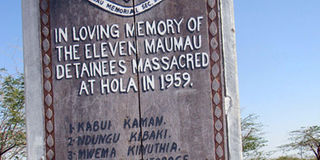Unsung gallant sons of the freedom struggle who share a tomb in Hola

LABAN WALLOGA| NATION
A plaque bearing the names of the 11 Mau Mau detainees massacred in 1959 by the colonial forces in Hola Town. The country marks the inaugural Mashujaa Day Wednesday.
As Kenyans mark Mashujaa Day today, a group of 11 long-dead villagers may continue to be the unsung heroes of the liberation struggle.
With no one to speak on their behalf or about their exploits, the 11 have for decades since independence remained a largely an unheard of lot.
They are in a mass grave in the dusty town of Hola, the headquarters of Tana River district.
It is situated right at the entrance of Mau Mau Memorial girls secondary school. Their tombstone, surrounded by shrubs, draws scant attention from passers-by.
The tombstone is inscribed: “In loving memory of the 11 Mau Mau detainees massacred at Hola in 1959.”
Their names are Kabui Kaman, Ndungu Kibaki, Mwema Kinuthia, Kinyanjui Njoroge, Koroma Mburu, Karanja Munuthi, Ikeno Ikiro, Migwi Ndegwa, Kaman Karanja, Mungai Githi and Ngugi Karitie. The school is located at Nyakiambi five kilometres from Hola township.
Even though they have never been mentioned during independence day celebrations, locals speak highly and proudly of them.
Their heroism goes back to September 20, 1952 when they were uprooted from they homes in Central Province and detained at Hola at the height of the war of liberation.
Their account is given by 97-year-old Kariuki Wanjohi who recalls that the 11 out of 300 were massacred by the white men in cold blood after they refused to work as slaves in farms – the current Hola irrigation scheme.
Wanjohi, who lives at Kiamyaka village, which was abandoned by the National Irrigation Board after the collapse of cotton farming in 1987, says colonial guards incensed by the prisoners’ show of defiance clobbered them with gun butts leaving many in a coma.
Wanjohi says he is lucky to be alive as he too was gun butted.
Speaking to journalists at his home Wanjohi says 11 were beaten and then thrown out of a flying aircraft.
This aspect of the story could not be verified as we could not locate any other survivors.
However, three years ago another Mau Mau survivor Mathenge Ngatia who has since died of pneumonia at his home in Karatina in Nyeri claimed that only few of Mau Mau fighters at the Hola camp survived the punishment.
Ngatia, who claimed his testicles were crushed by the colonial soldiers, publicly appealed to the Kibaki administration to look into the fate of those who have fought for this country.
“This is the time the government to look after those who have fought for this country, they should be recognized as people who saved this country from colonialists.” he said during one Kenyatta Day celebration shortly before he died.
At the Hola mass grave, the principal of Mau Mau Memorial secondary school Hamaro Silyvano said that besides government support, the school has also received computers from the Jaramogi Oginga Odinga foundation as a memorial for freedom fighters.
She expects more visitors to flock to the school to pay homage to the freedom fighters in the new constitutional order which sets aside October 20 for remembrance of all who fought for the country’s independence.




